What Is the Difference Between Maine Coon and Norwegian Forest Cats?
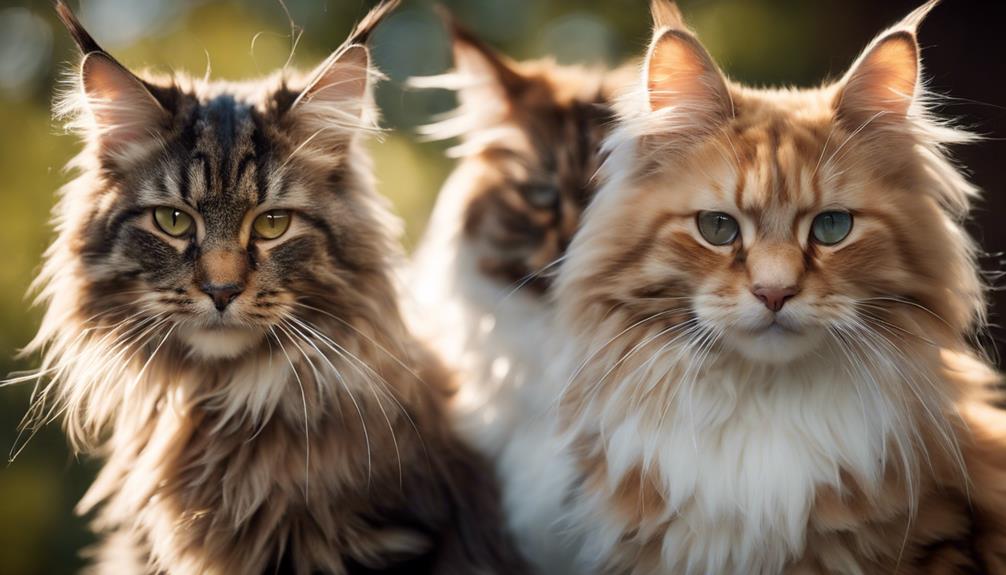
Maine Coon and Norwegian Forest Cats differ in their size and origin. Maine Coons are larger and originate from the United States. Norwegian Forest Cats, on the other hand, are smaller and come from Norway.
Breed History
The historical origins of the Norwegian Forest cats and Maine Coons reveal distinct paths shaped by geographical influences and human interaction. Norwegian Forest cats trace their roots back to Scandinavia, where semi-longhair cats brought by Vikings during the Middle Ages evolved into the robust breed known today. These cats developed a strong body and a thick, water-repellent coat to survive Norway's harsh climate.
In contrast, Maine Coons are believed to have European origins, possibly arriving in the 18th century with seafarers. The breed gained popularity in Maine during the 19th century, eventually becoming the official state cat. Despite facing near extinction at various points, both breeds were saved through dedicated breeding programs and later earned recognition from official cat associations.
The unique historical backgrounds of the Norwegian Forest cats and Maine Coons have contributed to their distinct characteristics and personalities, making them beloved companions for many.
Physical Characteristics
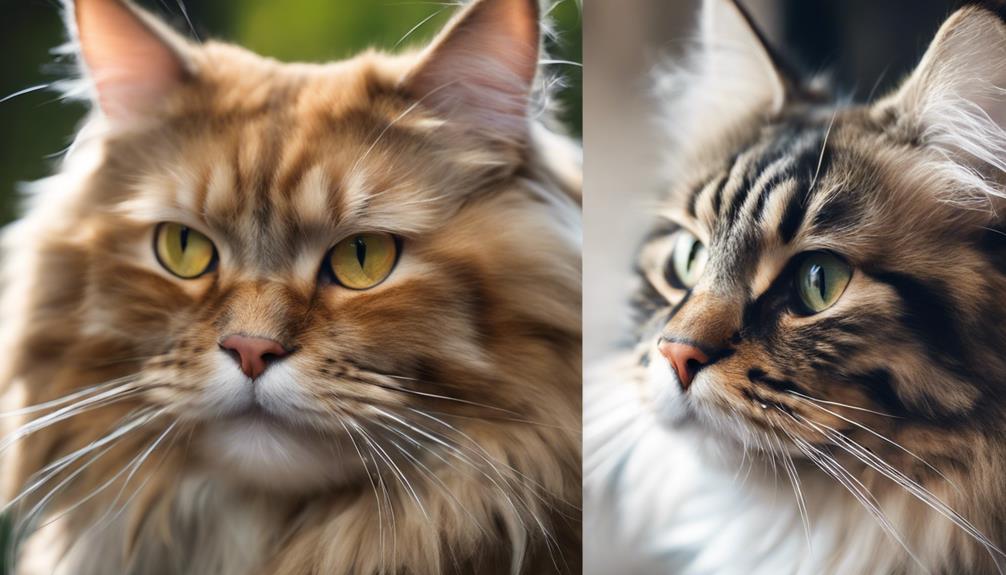
Maine Coons and Norwegian Forest cats exhibit distinct differences in their physical characteristics. Their coat length and texture vary significantly, with Maine Coons boasting a silky uppercoat and soft undercoat, while Norwegian Forest cats possess a wooly undercoat and water-repellent upper coat.
Additionally, Maine Coons generally have a broader chest compared to Norwegian Forest cats, whose high-set legs give them a unique stature.
Coat Length and Texture
With contrasting coat textures and lengths, Maine Coon and Norwegian Forest cats exhibit distinct physical characteristics that influence their grooming needs and resilience to weather conditions.
- Maine Coons have a semi-long fur with a silky uppercoat and a soft undercoat, while Norwegian Forest cats have a wooly undercoat and a water-repellent upper coat.
- The coat of a Maine Coon cat may have longer fur around specific areas, while the Norwegian Forest cat has an even-length coat all over the body.
- Maine Coons typically require more grooming attention due to their longer and silkier fur compared to the more low-maintenance coat of Norwegian Forest cats.
- The water-repellent upper coat of Norwegian Forest cats helps them withstand harsh weather conditions, while the Maine Coon's coat is known for its soft and silky texture.
Size and Build
Distinctive from their coat differences, the size and build of Maine Coon and Norwegian Forest cats play a significant role in defining their physical characteristics and overall appearance. Maine Coons are known for their larger size, weighing up to 25 pounds, compared to Norwegian Forest cats, which are slightly smaller at around 20 pounds. Maine Coons have a robust, square build with a broader chest and a more muscular appearance, while Norwegian Forest cats exhibit a more elegant, sleek look with a triangular head shape and straight nose. Maine Coons also typically have larger ear tufts and bushier tails, adding to their distinctive features.
These size and build variations between Maine Coons and Norwegian Forest cats are adaptations that help these breeds thrive in different environments.
Facial Features
How do the facial features of Maine Coon and Norwegian Forest cats differ in defining their physical characteristics? Maine Coons and Norwegian Forest Cats exhibit variations in facial features that contribute to their unique appearances.
- Maine Coons have a square, slightly elongated head with a square muzzle, while Norwegian Forest cats possess an almost equilateral triangular head with a long, straight profile.
- Maine Coons typically have large, slightly oval eyes, whereas Norwegian Forest cats boast large, almond-shaped eyes.
- Both breeds feature large, wide ears with or without lynx tips, but Maine Coons tend to have a broader chest when compared to Norwegian Forest cats.
- Maine Coons present a more lion-like appearance with a wider muzzle, while Norwegian Forest cats display high legs with hind legs slightly higher than their front legs.
Origins and Lineage

Norwegian Forest cats likely trace their lineage back to Siberian or Turkish longhair cats, contrasting with the potential European origins associated with Maine Coons. The Norwegian Forest cats have their roots in Scandinavia, believed to have evolved from semi-longhair cats originating from the Middle East.
Conversely, Maine Coons are linked to the state of Maine in the USA, showing a possible connection to European seafarers. These differences in origins have influenced various aspects of the two breeds.
Norwegian Forest cats, having arrived in Scandinavia around the Middle Ages, were utilized as mousers by the Vikings. In contrast, Maine Coons are theorized to have arrived with the Vikings in the 11th century or later with European seafarers.
The distinct lineage of each breed also contributes to their physical characteristics, with Maine Coons often displaying wider muzzles and a more lion-like appearance compared to the regular cat face of Norwegian Forest cats.
Temperament and Behavior
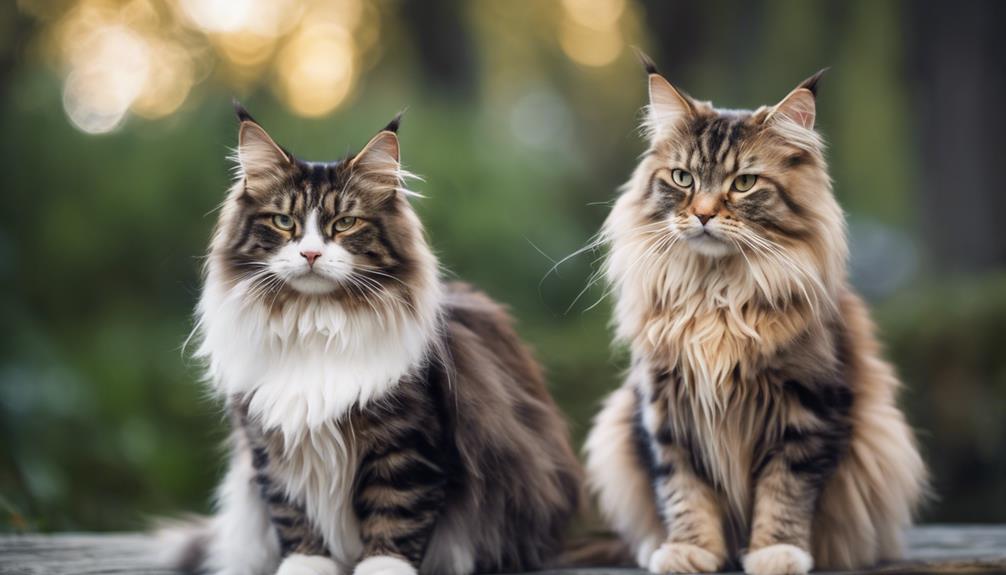
Maine Coons and Norwegian Forest cats exhibit distinct personality traits that significantly influence their interaction with humans. Maine Coons, with their high energy levels and intense playfulness, tend to seek more active engagement with their owners, displaying loyalty and affection.
In contrast, Norwegian Forest cats, known for their laid-back demeanor and independence, prefer a more relaxed and less demanding companionship, making them suitable for individuals seeking a more low-key feline companion.
Personality Traits
When comparing the personality traits of Maine Coon and Norwegian Forest cats, it becomes evident that their temperaments and behaviors distinctly reflect their individual breed characteristics.
Personality Traits:
- Affectionate vs. Independent:
- Maine Coons are openly affectionate, clingy, and enjoy spending time on laps.
- Norwegian Forest cats are loyal but less overtly affectionate, independent, and less needy.
- Vocalization and Sociability:
- Maine Coons tend to be more vocal and sociable.
- Norwegian Forest cats are quieter, calmer, and less demanding of attention.
- Playfulness and Temperament:
- Maine Coons are chattier and more playful.
- Norwegian Forest cats exhibit a quieter demeanor and prefer shorter play sessions.
- Adaptability and Social Interactions:
- Maine Coons are more adaptable to social interactions.
- Norwegian Forest cats may require more time to accept new animals or changes in their environment.
Interaction With Humans
In assessing the interaction between humans and these distinct feline breeds, one can observe contrasting temperaments and behaviors that shed light on their unique characteristics.
Maine Coons display dog-like loyalty, high energy levels, and a love for interactive play, making them affectionate companions who seek attention and form strong bonds with their owners. They're trainable and thrive on human interaction, often enjoying activities like leash-training.
Conversely, Norwegian Forest Cats are more laid-back, preferring shorter play periods and napping. While intelligent and trainable, they exhibit a reserved demeanor, being less outgoing than Maine Coons. Norwegian Forest Cats may be less interested in training and are better suited to quieter, calmer environments, reflecting their independent nature when it comes to interacting with humans.
Health and Lifespan
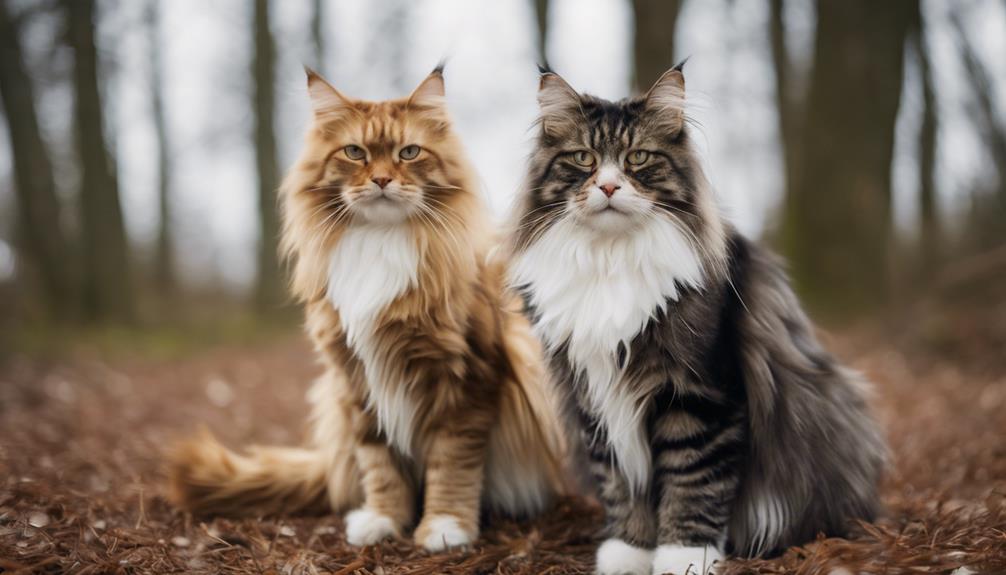
Comparing the health and lifespan of Maine Coon and Norwegian Forest cats reveals notable differences in average longevity and potential genetic predispositions.
- Average Lifespan: Maine Coons typically live 10-15 years, whereas Norwegian Forest cats have a longer average lifespan of 14-16 years.
- Genetic Predispositions: Maine Coons are prone to joint problems and hypertrophic cardiomyopathy, a heart condition. On the other hand, Norwegian Forest cats may be at risk of Glycogen storage disease type IV, a genetic disorder affecting glycogen metabolism.
- Longevity with Care: With proper care and regular veterinary check-ups, both Maine Coons and Norwegian Forest cats can live up to 20 years, surpassing their average lifespans.
- Regular Veterinary Visits: It's crucial for both breeds to have routine vet visits to monitor their health closely and detect any potential health issues early on. This proactive approach helps ensure a longer and healthier life for these beloved feline companions.
Grooming and Care Needs
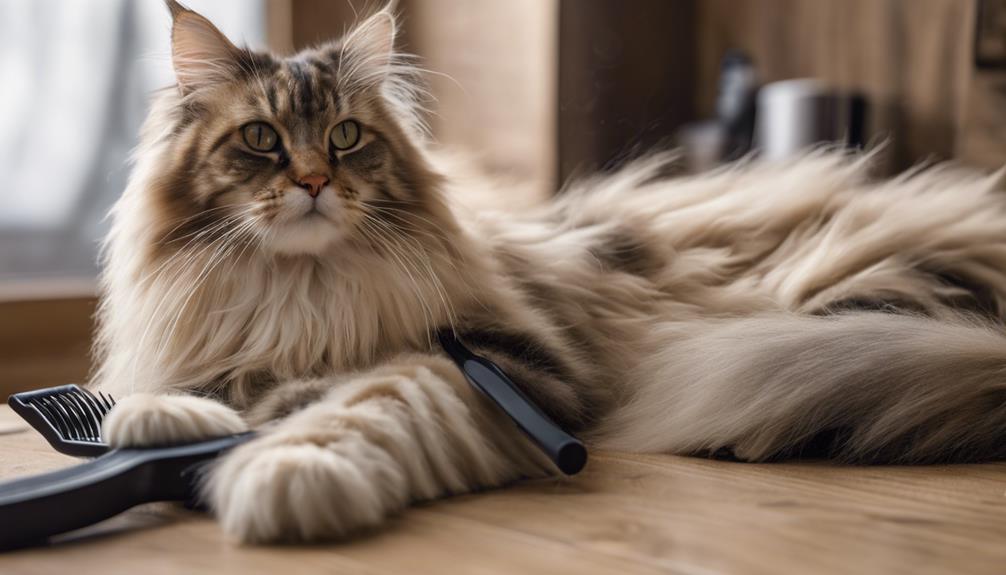
Maintaining the grooming and care needs of Maine Coon and Norwegian Forest Cats presents distinct challenges due to their differing coat types and grooming habits. Maine Coons have long fur that requires regular grooming to prevent matting and tangles. They shed seasonally and may need more attention to grooming compared to Norwegian Forest Cats. Brushing is essential for both breeds, with Maine Coons possibly needing more frequent brushing sessions to keep their coat healthy.
On the other hand, Norwegian Forest Cats have a water-repellent coat and are known for their self-grooming habits, requiring minimal external grooming. Their fur is less prone to matting, making them relatively low maintenance in terms of grooming. While both breeds shed, Maine Coons generally require more assistance in managing their shedding through grooming practices.
Understanding the specific grooming needs of each breed is crucial to ensuring their well-being and keeping their coats in optimal condition.
Maine Coon Vs. Norwegian Forest Cat Mixes

A comparison between Maine Coon and Norwegian Forest Cat mixes, also known as Wegie Coons, reveals a blend of size, appearance, and temperament influenced by both parent breeds. When considering these hybrid cats, it's essential to understand the traits, potential health concerns, and temperament they may inherit:
- Varied Traits: Wegie Coons may exhibit a combination of physical attributes from both the Maine Coon and Norwegian Forest cat, such as tufted ears, bushy tails, and large, sturdy bodies.
- Health Concerns: Due to their genetic makeup, these mixes could be prone to joint problems common in both parent breeds. Regular veterinary check-ups are crucial to monitor and address such issues promptly.
- Inherited Temperament: The offspring of a Maine Coon and Norwegian Forest cat cross can display a mix of temperamental traits like loyalty, playfulness, independence, and affection. This blend makes Wegie Coons unique and unpredictable in their behavior.
- Unique Blend: Wegie Coons offer a distinctive mix of characteristics that cat enthusiasts find intriguing, combining the best of both parent breeds in one fascinating feline.
Frequently Asked Questions
Which Is Better Maine Coon or Norwegian Forest Cat?
Maine Coons and Norwegian Forest Cats both have unique qualities. Depending on one's preference, Maine Coons may be better for those seeking a vocal, playful companion with higher grooming needs, while Norwegian Forest Cats might suit individuals desiring a quieter, low-maintenance pet.
How Can You Tell if a Cat Is a Norwegian Forest Cat?
To identify a Norwegian Forest cat, look for their distinctive coat patterns, prominent ear tufts, large size compared to other breeds, almost equilateral triangular face shape, friendly and independent personality traits, and their moderate grooming requirements.
Are Maine Coon Cats Descended From Norwegian Forest Cats?
Maine Coon cats are not directly descended from Norwegian Forest cats, but they may share genetic similarities. They exhibit differences in coat patterns, size variations, and temperament. Despite possible historical connections, these breeds have distinct characteristics setting them apart.
How Can You Tell if a Cat Is a Maine Coon?
When identifying a Maine Coon, notice its distinct features like various coat patterns, prominent ear tufts, large size compared to other breeds, friendly and playful personality traits, square facial features, and a long, bushy tail.











